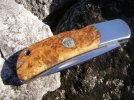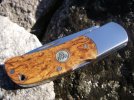- Joined
- Jul 27, 2016
- Messages
- 20
So I have just found out about Laurin Metalli blanks and want to build a few. My dilemma right now is handle material. I would like to use material from the woods but really do not want to wait for seasoning. I'm an amateur, so let me know if this is possible. Go in woods harvest dead standing/ dead branches. Cut to size and throw in oven and slowly "cook" them. There was a YouTube video of someone doing this. I feel like they shouldn't warp much because they will be blocks not thin slabs. Proceed with making the knife via hidden tang, epoxy method. Give it a soak in boiled linseed oil when done.
So if I do this what should I look out for in potential problems with the knife? Any further recommendations on ways to go on this way would help.
Thanks
So if I do this what should I look out for in potential problems with the knife? Any further recommendations on ways to go on this way would help.
Thanks




